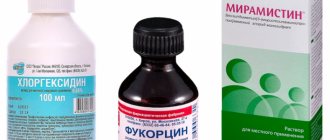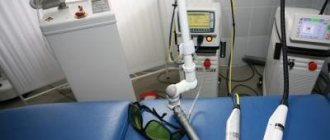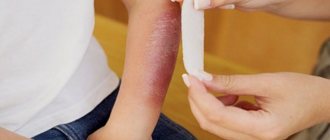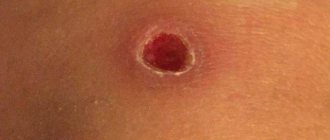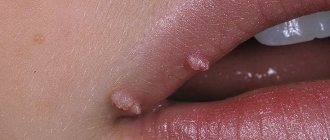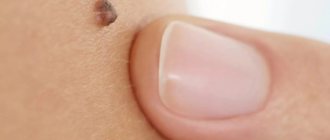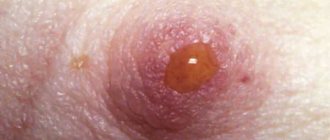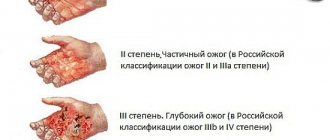Structure of a wart
Papilloma is a keratinized, compacted spot that has visible boundaries. It can be soft or rough to the touch. Localization is of great importance.
The tissues of the growth differ in color and can be yellowish, red, or brown. The structure of the growth indicates the obligatory presence of a base. The roots of a wart are part of a neoplasm that is located in the deep layers of the skin. When a growth appears, its root penetrates the vessels and “pulls” from them the necessary elements to nourish the papilloma.
The roots of warts that have appeared recently are white or red. They are represented by thin threads that turn black over time. With mechanical removal, it is almost impossible to completely pull out the root. In addition, if it penetrates deep into the cells of the epidermis, there is a possibility of scars appearing. What does the root of a wart look like in cross section:
- The top layer of growth, slightly rising above the skin.
- Epidermis
- Dermis.
- Directly roots.
- Fatty fiber.
The structure of the roots is branched, thread-like. When mechanical removal is performed, part of the base may remain deep under the skin. Under favorable conditions, the residue will begin to germinate, promoting the appearance of a new growth.
How to treat a wound after wart removal?
Warts are a general name for benign neoplasms. Viral etymology. The cause of such growths on the skin is the papillomavirus. Penetrating into the bloodstream, HPV is integrated into the DNA of epithelial cells, leading to their growth and the appearance of warts. In addition to being an aesthetic problem, warts located on various parts of the skin can constantly be rubbed or squeezed, causing pain to their “owner”.
There are various ways to combat unwanted tumors:
- Laser destruction;
- Radio wave removal;
- Cryodestruction;
- Surgical excision;
- Electrocoagulation;
- Use of medications;
- Treatment with folk remedies.
The method of getting rid of growths is chosen by a specialist, depending on their size, location, and the presence of chronic diseases in the patient.
Skin recovery time after wart removal
Even the newest low-traumatic removal methods - laser destruction, radio wave exposure, cryodestruction - cause a slight burn of the epithelium. Healing of damaged skin occurs in stages:
- Formation of a crust that protects the wound from infection;
- Regeneration of the epithelium under the scab (crust);
- The death of the crust, its removal, the formation of healthy skin.
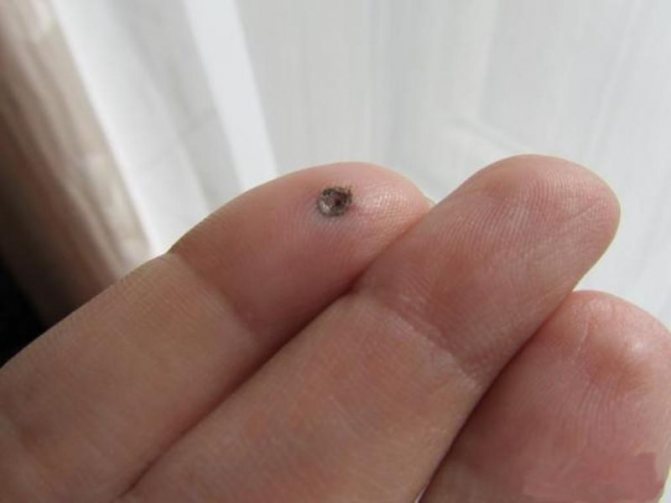
Young skin at the site of the removed tumor initially differs in color and structure from the rest of the skin, but this goes away over time.
The wound after removal must be treated correctly, in accordance with the recommendations of the attending physician. Neglect of postoperative care can cause complications: the wound becomes inflamed, festers, the skin around it swells and becomes bright red. The duration of the regeneration process depends on:
- The size of the removed tumor. The larger the size, the longer the recovery period. On average, this process takes from several weeks to two months;
- Level of immune protection. The stronger the immune system, the faster the wound heals;
- Compliance with all medical recommendations. If damaged skin is not treated, the risk of a secondary infection increases, the wound may fester, and the recovery process will take more than one month.
Postoperative care rules
After cauterization of the growth, the damaged area should be kept clean. This will help avoid infection and the appearance of purulent discharge. The scab must not be wetted, scratched, or exposed to prolonged heat or sunlight. Recommendations for treating healing skin will be given by your attending physician. An antiseptic and a vitamin complex are usually prescribed.
Caring for the wound after burning off a wart
At the site of the reduced formation, a depression remains, the size and depth of which depend on the size of the removed defect. During the day after the manipulation, swelling and redness of the tissue around the wound is observed. During cryodestruction, a blister may appear.
After cauterization, necrosis develops in the wart tissue, resulting in the formation of a crust consisting of lymph and clotted blood within two to three weeks. The crust tightly closes the wound, preventing the entry of pathogens. The film formed from dried lymph, and then the scab, plays the role of a “natural bandage”. It is under it that new healthy skin is formed. But in order for the crust to form, moisture must be avoided. Fresh air will help dry the surface of the wound, where lymph initially appears.
Premature peeling of the crust can be caused by its overdrying or softening. Therefore, the wound should heal in a clean and dry manner. Do not wet the damaged area or treat it with greasy cream, Vaseline or ointment. It is worth reducing the time spent in the open sun. Exposure of the crust to sunlight can cause it to dry out.

If infection cannot be avoided, only a professional doctor should treat purulent wounds after cauterization. To do this, the scab is treated with furacillin, potassium permanganate or hydrogen peroxide. Then they carefully lift the separated part and cut it off with a scalpel or surgical scissors, leaving the portion of the scab that fits tightly to the wound.
If the regeneration process occurs without pathologies, a young pinkish epithelium is formed in place of the scab that has disappeared. After a couple of months, the young skin will be equal in shade to the main epithelium.
Caring for young skin involves a number of restrictions:
- It is forbidden to cleanse the skin with a scrub, wipe with lotions containing alcohol, or apply steroid ointments;
- It is recommended to temporarily avoid aggressive household chemicals;
- Avoid pumice stones and washcloths during hygiene procedures;
- Stop using the razor until the skin is completely restored;
- Do not apply decorative cosmetics;
- When going outside, apply sunscreen with a factor of at least 30.
Correct behavior in the postoperative period will help maintain not only the health, but also the beauty of your skin, protecting it from the appearance of burns and age spots.
Possible complications
The occurrence of complications after removal of a growth is associated with the wrong choice of treatment method, an unsuccessful procedure, or non-compliance with the rules for caring for the wound.
Scarring
The most common complication after a wart removal procedure is scarring of epithelial tissue. The reason for the development of such a pathological process may be:
- Inexperience of the specialist who performed the manipulation;
- Genetic tendency to form colloidal scars;
- Violation of wound care rules in the postoperative period;
- Infection of the damaged area;
- Premature removal of the crust;
- Excision of large deep tumors.
The effect of a laser beam on the epithelium is similar to a sunburn. Therefore, the area of skin treated with the laser turns red. If there is increased individual sensitivity to solar radiation, after the procedure, swelling and redness of the skin around the removed tumor may occur. In especially severe cases, blisters are observed, which scar over time and acquire a brown tint.
Such complications can be avoided if you care for the wound in accordance with the recommendations of your doctor. If, despite all your efforts, swelling and redness does not go away, you should not self-medicate. Seek advice from a specialist.
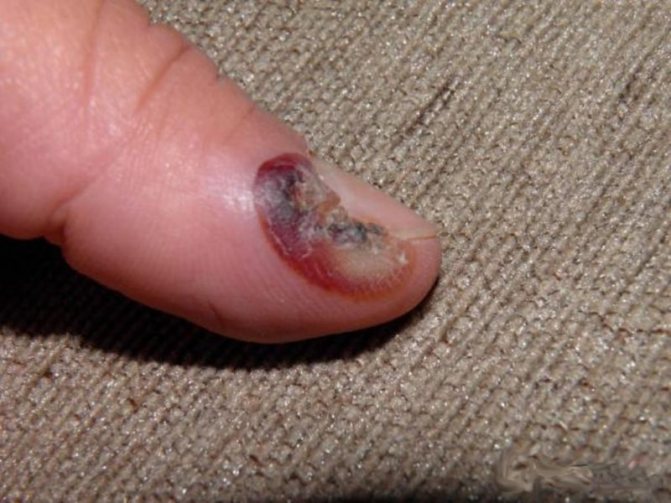
Inflammatory process
The inflammatory process is accompanied by symptoms such as redness of the damaged area, pain and fever. Don't be afraid. This is the body's reaction to the manipulation. All symptoms should disappear within five days.
If these symptoms do not disappear for more than seven days, you should consult a doctor. Since a long-term inflammatory process can be a consequence of infection of the wound. You will need to treat the damaged area with an antiseptic or take a course of antibiotics.
Pain syndrome can be observed until the wound is completely healed. This is due to the patient's low pain threshold. If painful sensations are accompanied by purulent discharge, this indicates the development of a secondary infection. Contact the specialist who performed the manipulation. He will treat the damaged skin with an antiseptic and, if necessary, apply stitches. In addition, the doctor will prescribe a pain reliever to relieve pain.
Prevention of complications
Most often, it is the patient himself who provokes the development of complications. Neglect or improper care of damaged skin, peeling off the crust, the use of decorative cosmetics along with a weakened immune system prevents the regeneration of the epithelium.
In rare cases, a secondary infection is associated with a non-healing wound, accompanied by pain and discharge of pus. To avoid adverse effects, strictly follow the care recommendations.
The list of medications is prescribed by the doctor based on the individual characteristics of the patient. But it necessarily includes anti-inflammatory drugs and antiseptics.
Protection against infection
To prevent the development of the inflammatory process at the site of the removed tumor, the wound should be treated with a solution of brilliant green, blue or potassium permanganate. When the scab falls off, the young skin is lubricated twice a day with hydrocortisone ointment for a week.
Help with regeneration
To speed up the healing process, aqueous solutions of retinol and vitamin E are used. The cream, which contains hyaluronic acid, will help the skin restore elasticity, protect it from an aggressive environment, and soften damaged tissue. Mild acid peeling helps remove dead epithelial cells without causing harm to young skin.

In addition to external effects, young skin needs nourishment from the inside. Therefore, you cannot do without taking complex products that contain vitamins, minerals and microelements necessary for the regeneration of skin cells.
When choosing a specialized clinic to perform a wart removal procedure, it is better to give preference to a trusted institution with a good reputation and qualified specialists. This will be the key to a successful manipulation with minimal risk of complications.
Sources used: papillomam.net
Causes and types of warts
The growths that cover the skin are the result of infection with a virus. There are more than 100 types of HPV, which contributes to the appearance of warts. The infection enters the human body through skin wounds during contact with a sick person. It is easy to become infected in public places where the virus is transmitted through shared items. The following types of warts are distinguished:
- Vulgar, or simple, growths have a dense structure, a shade close to the color of the skin. Appear on the knees, hands, fingers.
- Flat warts resemble smooth spots with a flat surface that rise slightly above the skin. Usually appear in teenagers.
- Plantar or plantar warts. Their roots penetrate deep into the skin. Outwardly, they resemble hard spots that appear on a person’s feet and cause discomfort while walking. In some cases, the growths protrude strongly above the skin and have a “terry” structure.
- Filiform papillomas visually resemble papillae that grow in length. The color varies from natural to brown, the structure is elastic. These warts have small roots.
- Pointed growths affect the genitals and are distinguished by a conical shape. They can grow quickly, provoking destructive changes in adjacent tissues. When such formations appear, immediate treatment is indicated.
Warts have a characteristic appearance. They are easily differentiated from each other.
The presence of a wart with black roots indicates an old form of the disease. But sometimes this can be a defensive reaction to infection, leading to the spontaneous death of the growth. Blackening of the roots occurs when the treatment is properly selected or when the upper part of the growth is damaged.
Instructions for using celandine for warts
Celandine for warts is one of the effective treatments for the problem.
Almost everyone is familiar with warts - these unpleasant growths can be found in both adults and children.
Celandine has been used for various skin problems for many decades, not only to remove warts, but also to solve other skin problems. So, how to remove a wart with celandine correctly?
Why do warts appear?
Warts or papillomas are small growths on the skin that are benign.
They appear on the body due to the human papillomavirus, which can be infected through contact.
The virus can hide in the human body for a long time, and under certain circumstances appear.
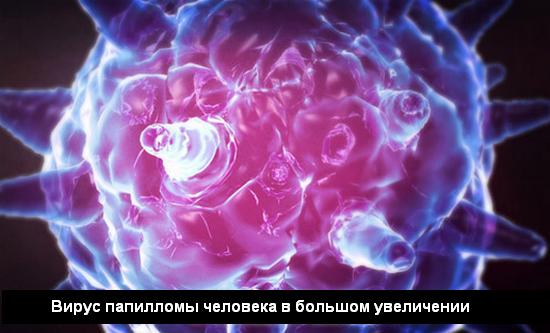
Factors that provoke the appearance of papillomas can be a decrease in the body's defense mechanisms, neuroses, mental trauma, increased sweating and much more.
The appearance of papillomas is very unpleasant; in addition, they can cause pain, reduce performance and impair the quality of life.
Most often, you can find common warts in the form of nodules, which usually do not cause discomfort.
In adolescents, you can also find flat growths, which are usually almost invisible. Another common type of growth is the plantar wart, which causes a lot of discomfort.
Treatment of papillomas does not take place in one moment, but includes a whole range of actions, including eliminating the causes that provoked the appearance of growths.
One of the methods for treating growths that doctors offer is surgical removal of papillomas.
However, after such treatment, a scar may remain at the site of the wart, which is not always acceptable. Therefore, many who have discovered this unpleasant problem choose to remove warts with celandine.
Among all folk methods, celandine is the most popular; even doctors note its unique healing properties.
Before you independently treat warts with this plant, you should consult with specialists who will make an accurate diagnosis of the growth.
How does celandine work?
Celandine is a herbaceous plant whose flowering period occurs in June, and it ripens by September.
On the cut of the plant you can see yellow juice, which in large quantities can harm the skin.
You need to collect the plant very carefully; be sure to wear gloves and goggles that will protect the delicate surfaces.
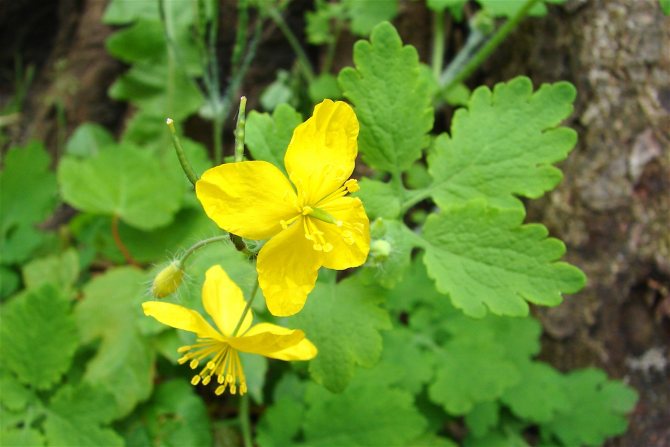
The most effective greenery of the plant will be during the flowering period. You should choose bright greens, without damage to the stems and leaves.
Why you should choose celandine to remove growths:
- unlike various medical procedures, as well as medicines, celandine juice does not bring any painful sensations - no pain, no burning;
- celandine is a natural remedy that can affect tumors;
- Celandine grows in almost every summer cottage, forest or meadow. This is an absolutely free treatment method.
- It is necessary to collect the plant for treatment only during its flowering period in May-June, otherwise it is unlikely that the wart will be removed;
- if the patient lives in the city, in this case it is better to buy a celandine-based product at the pharmacy than to look for weed in the urban jungle;
- plant concentrates that are sold in pharmacies can cause pain when applied, so you should be careful;
- treatment of warts with celandine lasts quite a long time;
- after treatment, wounds usually take a long time to heal and may leave marks on the skin;
- Celandine is a very powerful remedy that can cause allergies, especially in those who already suffer from some type of allergy.
Treatment of warts with home recipes
Traditional medicine recommends treating growths using plant juice, tinctures, compresses or oils. The most convenient method is to apply juice from a freshly cut plant to the sore spot.
Before the procedure, the sore spot is steamed in soda water. Next, the skin around the papilloma is lubricated with oil or rich cream so as not to harm it.
Now the herb juice is applied directly to the affected areas, 3 to 5 times during the day. If the wart turns black, it will soon fall off and you can stop the procedure.
Celandine for warts is also used in the form of an infusion. Fill the container 2/3 full with herbs, add vodka or alcohol and put it in a dark place.
This super remedy for removing papillomas will be ready in 3 weeks. It is filtered and applied several times during the day in the form of lotions for 20 minutes.
There is another recipe for infusion. The grass is ground, the juice is squeezed out and left for 2 days. After this, the extract is filtered and combined with vodka (2 to 1) or alcohol (4 to 1).
A super effect against papillomas is given by herb juice combined with propolis tincture 1 to 5. The infusion is set aside for 2-3 days. After this, the medicine is used twice a day for 1-2 weeks in the form of a compress (no more than 20 minutes).
According to reviews, an infusion of the plant in oil helps well against growths. Freshly picked grass is poured into a 0.5 liter jar up to the shoulders and filled with unrefined oil.
The jar is placed in a sunny place for 2 weeks, after which the product is used in the form of a compress for 12 hours. Continue therapy for 1 week.
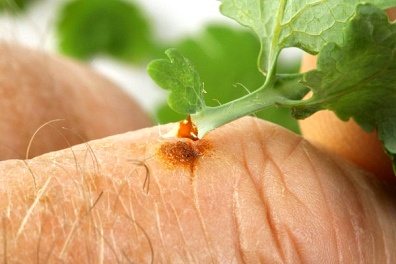
If the patient is bothered by plantar papilloma, then a special ointment helps to remove it. The juice or dry herb of the plant is combined with glycerin or petroleum jelly 4 to 1 and applied to the sore spot. The product must be stored in the refrigerator.
Some folk recipes advise taking a decoction of celandine internally. However, before such treatment you should definitely consult your doctor. 15 g of dry plant is poured with boiling water and wrapped for a couple of hours. Drink 0.5 cups three times a day before meals.
Pharmaceutical products with celandine
It is not always convenient for a city dweller to collect a plant, especially during its flowering period, and then collect the juice and prepare medicine. Therefore, you can buy ready-made products with celandine at the pharmacy.
According to numerous reviews, such medicines have super properties and help to effectively cauterize warts.
However, when choosing a pharmaceutical product for treatment, you should study all the reviews about it, as well as its composition, since some manufacturers deceive consumers.
For example, in pharmacies you can find the product “Super Celandine”, which does not contain a plant extract, and burning occurs with the help of acid or alkali.
Super Celandine contains potassium and sodium hydroxide and water, so you need to use this product very carefully.
Before using Super Celandine, you should treat healthy skin around the papillomas with a rich cream or oil.
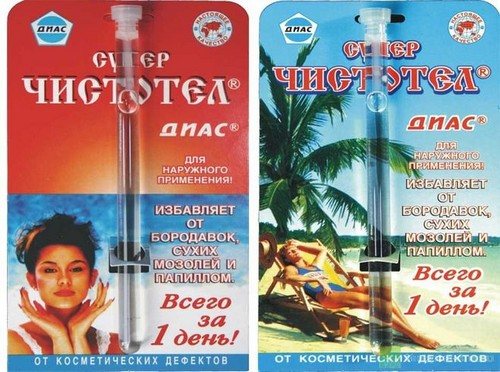
Instructions for using Super Celandine: before treatment, the growth is steamed, after which a minimum of medicine is applied with a special applicator until it begins to burn.
If the wart does not turn black and there is no burning sensation, you should repeat the procedure. According to manufacturers, within 5 to 10 days the skin will become clear of growths. If it was not possible to remove the growth, you should repeat the procedure 1-2 more times.
You can also treat growths with the pharmaceutical product Mountain Celandine. The product contains herbal extracts of celandine, gentian, golden rhododendron, and spear-shaped poop.
Mountain celandine helps remove warts, dry calluses, and papillomas. In addition to the fact that Mountain Celandine kills wart cells, it also has a local antiviral effect.
Mountain celandine can be used for psoriasis, calluses, and allergic dermatoses. For dermatoses, Mountain celandine relieves itching; in addition, the product is also used in dentistry.
Instructions for using the medicine: Mountain celandine should be applied to the wart with a stick or match so that the solution only gets on the wart itself.
Leave the product on the face and neck for 7 – 10 minutes, on the body – 10 – 12 minutes. Repeat the procedure 1-2 times a day, 2 – 10 days.
Before applying the medicine, the skin is steamed and dead particles are removed. The product has a very strong effect; contact of the drug with the eyes and mucous membranes should be avoided.
Celandine is a fairly effective remedy for skin growths. It should be remembered that it should not be used by children, pregnant or lactating women. The medicine can be taken orally only as prescribed by a doctor.
Sources used: zabotaokozhe.ru
Diagnostics
Examination of the emerging tumor is necessary to determine the exact type of human papillomavirus and to subsequently carry out the correct treatment. Which doctor should I contact for help? If a growth of any shape or color appears on the skin, you need to visit a dermatologist. Before removing the root of a wart on a finger, it is necessary to undergo diagnostics:
- Polymerase chain reaction (PCR) is a test that detects the presence of viral DNA in the blood. The degree of oncogenicity of the strain and its quantitative indicator are established.
- When removing the root of a papilloma on a finger or other part of the body, a histological examination may be prescribed. In this case, material is collected for analysis immediately before removal of the wart and after the operation. All affected skin layers are examined. A biopsy determines the benign quality of the seals and the possible degree of their degeneration.
- Digene HPV test is the most reliable HPV test; it makes it possible to detect a specific strain of the virus, the degree of oncogenicity, and concentration in tissues. The results obtained help to build the most accurate prognosis of the disease.
The structure of papilloma under a microscope
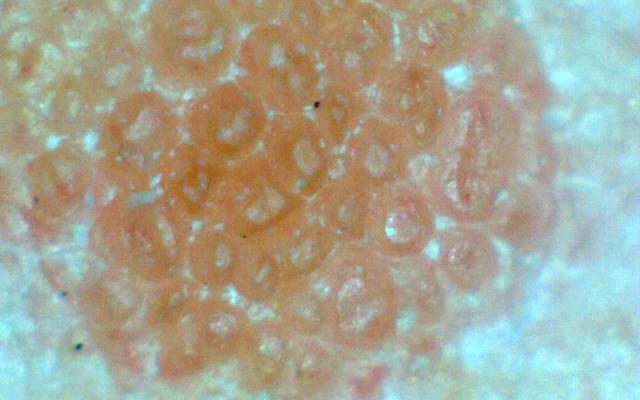
By papillomas, doctors mean limited single or multiple papillary outgrowths that look like cauliflower or a cockscomb, as well as dense nodules and papillae. They can be localized in different parts of the body, including mucous membranes. The human papillomavirus modifies the structure of the epidermis and causes:
- A special proliferation of cells, as a result of which a structure in the form of papillae is formed on the body. They are called papillae.
- The upper layers of the newly formed epidermis quickly die and become the stratum corneum. This is how warts form. Classic papillomas remain soft, not rough.
- Blood vessels form inside individual papillae.
- Papillae may die, and new ones may grow in their place.
Such processes determine the appearance of the tumor. Ordinary papillomas may be superficial, but through vessels they communicate with the dermis. The structure of warts (and plantar warts) is slightly different. Here the stratum corneum and black dots on the surface are clearly visible - this is how the feeding roots (vessels) appear. Plantar neoplasms have a particularly complex structure, since due to increased pressure (when standing and walking), their roots go deep into the soft tissues, and the papillae can grow quite strongly inward. In this case, while walking, the patient may notice the appearance of painful sensations, since the wart formation injures healthy tissue.
If you examine a papilloma or wart under a microscope, you can clearly see changes in the cellular structure of human skin.
How to remove the root of a wart
When removing a wart from its roots, small shoots may remain. There are numerous ways to remove such processes, but you must first undergo an ultrasound, which will show the depth of the lesion. Based on the results of the examination, the most optimal operation is selected.
If the root has grown greatly, the following methods will help to completely get rid of it:
- Freezing with nitrogen.
- Electrocoagulation.
- Laser therapy.
- Radiocoagulation.
In advanced forms of the disease, a surgical operation is indicated, during which complete excision of the wart along with the root is performed. Removing the growth with a scalpel is not a popular treatment method, but it is relevant if more gentle procedures have not brought benefit. After excision of the papilloma, a scar remains, which is a disadvantage of the procedure.
Traditional medicine is also effective in eliminating the roots of warts. How to eliminate growths and their remaining processes - at home and in the clinic, each person decides independently.
Doctor's help
Laser removal of warts along with the roots is quick and painless. Laser therapy is carried out in a hospital setting. Laser removal of the roots of a plantar wart, which most often causes discomfort to a person, is accompanied by the presence of minimal scars. In addition, relapse of the disease is almost 100% excluded. The accuracy of the method is ensured by maximum control of the depth of penetration of the beam and the area of its impact.
How else can you remove the root of a wart? Cryotherapy is widely used. The growth is exposed to low temperatures. The seal freezes and its structure is destroyed. A huge advantage of the method is the absence of scars. With the help of freezing, papillomas with shallow roots are removed, since the doctor cannot control the exact depth of the cold. In addition, prolonged exposure to low temperatures can damage adjacent healthy tissue, leaving scars.
How a wart is cauterized with liquid nitrogen (cryotherapy)
In this case, several different paths can be considered, depending on which method will best suit the patient:
- Laser removal;
- Excision with a radio wave knife;
- Freezing a wart with liquid nitrogen;
- Electrocoagulation;
- Removing the growth with a scalpel (used very rarely).
As mentioned earlier, in addition to all this, drugs are prescribed that increase immunity and actively suppress the virus. Which method to choose to combat warts is initially determined by the patient himself, but you definitely shouldn’t wait for such skin formations to go away on their own; for this you need to at least try to improve your immunity.
What is the root of a wart?

The roots of the wart are the lower part of the tumor, which are located in the deep layer of the skin; they supply the formation - supply it with the necessary amount of oxygen and nutrients
The root of a wart is the subcutaneous part of the growth. The wart nodule or ball itself is only the outer part of the growth. Most often, such neoplasms are harmless. The problem lies precisely in the root, which goes deep under the skin. This part contains thin blood vessels through which blood enters the growth.
The roots of the wart are not visible in the photo, as they go into the deeper layers of the skin. If the wart has been present for a long time and has grown deep under the skin, upon careful examination you will notice a small black dot in its center, which is the base of the growth. The subcutaneous location of the root causes the risk of re-formation of papilloma if its body is removed but the root is not damaged.
All warts have roots. In papillomas and condylomas they are rarely large; in a flat wart the root is small. The largest bases are observed in the spinules. These are plantar warts, which in appearance resemble a small plaque or a large island of keratinized skin. The base of such a wart goes very deep. It is the roots of plantar warts that most often turn black. The large root system of such a growth causes pain when pressed. This is due to the fact that the root compresses the surrounding tissues, irritating the nerve endings, and in response to this pain occurs.
It is impossible to examine the root of a small growth on your own. Armed with a magnifying glass, you can notice a changed color of the epidermis and black rods, but only in large warts that have been present on the body for a long time.
Treatment of young patients
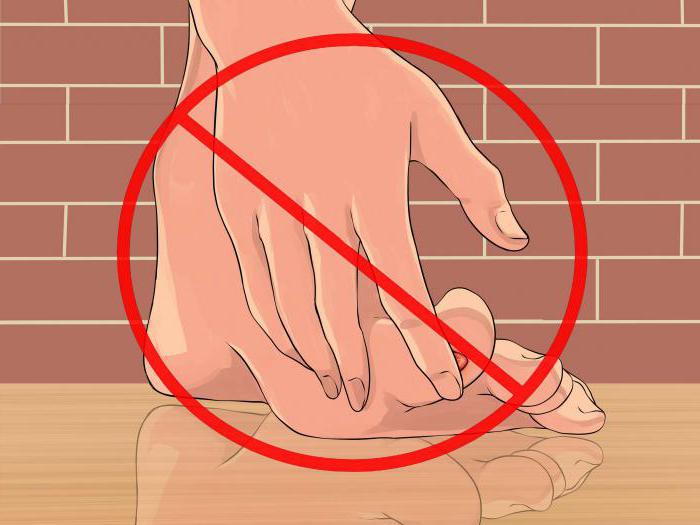
Laser removal of plantar warts in children can be performed under local anesthesia. But a doctor must refer you for this procedure. After its completion, it is advisable to apply a bandage to the treated area.
Similar article - Ethoxamine instructions for use
Parents should know that there will be a small depression at the site of the wart; it will become covered with a crust. It is important to ensure that the child does not try to remove it himself. After all, this is how you can get an infection. After a few days, the crust will dry out and fall off on its own. It is better to protect yourself and your baby and cover the wound with a bactericidal bandage.
How to pull out a wart by the roots?
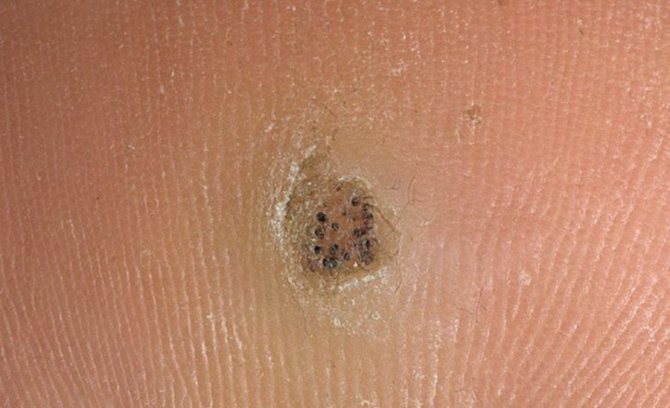
The black color of the root is not a dangerous sign - darkening often occurs in old and deep growths
Having figured out what the roots of a wart look like and what they are, you should figure out how to deal with them. Removing only the visible part of the papilloma will not give the expected result. The root will continue to be nourished by the blood vessels and over time a growth will form again in the same place.
The best way to remove the root of a wart depends on the type and size of the growth. The virus that causes the formation of papillomas is concentrated precisely in the root part and in the body of the neoplasm. Damage to the root without removing it can lead to the virus spreading to surrounding tissues and new papillomas appearing around existing ones. In this case, the first wart will be called the mother wart, and smaller growths will form around it.
The base or root of a wart can be removed in several ways:
- surgical excision;
- professional cauterization;
- special drugs.
The surgical method (excision with a scalpel) is practiced only for the removal of old warts, condylomas and growths, the large roots of which go deep under the skin, which can be seen in the photo, schematically depicting the inside of the tumor.
It is advisable to use preparations for removing papillomas to remove young growths that have recently appeared on the body, which means that their roots have not yet grown sufficiently under the skin.
Pharmacy products
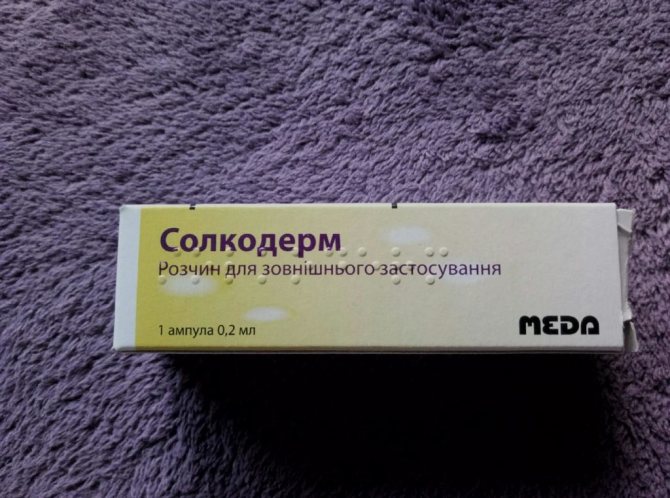
Solcoderm is a medicinal product intended for the treatment of warts and calluses, the effect of the drug is limited to the area of application
The following medications will help both remove the root of the wart and prevent the appearance of papillomas in the same place:
Verrucacid is a product that contains phenol and an antibacterial substance. The drug burns the wart to the base, disrupting its nutrition. One drop of the product is enough to remove a small papilloma from the root. The drug is applied once to the body of the growth. If after three days the wart has not turned black, you can repeat the treatment. To remove small papillomas, it is enough to use the product once; to get rid of large growths, you need to apply the product up to three times, maintaining a three-day break between treatments.
Solcoderm is a solution based on four acids that burns the body and root of the wart. The drug is applied using a special applicator to the top of the wart. If necessary, re-treatment can be repeated every other day. The effectiveness of the product is indicated by a decrease in the size of the growth and its blackening.
Supercleaner is the most affordable product for removing warts at home. The product is a potent alkaline solution that burns the wart, causing tissue necrosis. It needs to be applied once. Celandine grass is not included in the composition, despite the name.
What to do with them
Photo of a blackened wart
As you can see, the growth can darken as a result of various phenomena. Many medications and traditional methods of treatment cause the top layer of the wart to turn black and soon fall off. This is a natural process that everyone who has encountered papillomas wants to achieve.
If you notice that the wart has become dark in color and is causing you some concern, do the following:
- Visit your doctor. Start with a dermatologist, who, if necessary, will refer you to an oncologist to rule out the possibility of developing a cancerous tumor. This is a natural procedure that is needed to calm the patient or to identify a problem in a timely manner;
- If the doctor finds that the darkening of the wart is due to potentially dangerous factors, then he will prescribe surgical removal;
- When dark growths appear as a result of safe and natural processes, you can either wait until the wart falls off or prescribe treatment;
- Treatment should only be prescribed by a specialist. Do not try to choose medications that you do not understand on your own. Sometimes it is enough to undergo a course of treatment with antiviral drugs, and for some it is recommended to resort to action directly on the body of the wart itself.
Treatment methods
Blackened warts, which you can see in the photo, if there is no potential danger, are treated at home. For these purposes, various methods and preparations are used.
- Treatment of papillomavirus. Many people equate treatment with removal. But simply removing the papilloma will not get rid of the very cause of its appearance - the human papilloma virus. Unfortunately, HPV is currently considered incurable. Therefore, the essence of treatment is to suppress the virus and help restore normal functioning of the immune system. To do this, the doctor prescribes antiviral drugs, drugs to enhance immunity and vitamin complexes. At the same time, it is recommended to make adjustments to your lifestyle, get rid of bad habits and eliminate factors that negatively affect the state of your immune system.
- Cauterization of warts. Even blackened warts can be cauterized to remove them quickly. Aggressive drugs such as Feresol, Verucacid or Kolomac, for example, should be used extremely carefully, trying not to affect the healthy skin near the wart. If there is no need for haste, it is better to resort to safer means.
- Mild effect on papillomas. It is best to use medications that help the immune system fight warts. The optimal choice would be topical medications based on synthesized interferon. These primarily include Panavir and Viferon.
- Surgical removal of papilloma. If a black growth causes you physical or psychological discomfort, it is better to remove it. To remove darkened papillomas, it is recommended to use laser coagulation methods, radio wave excision or cryodestruction.
How to remove a wart from the root
After removing a wart, a relapse sometimes occurs in its place, that is, a growth appears again.
It could also form nearby.
The reason is that during removal, not all the roots of the wart were removed.
- All information on the site is for informational purposes only and is NOT a guide to action!
- can give you an ACCURATE DIAGNOSIS !
- We kindly ask you NOT to self-medicate, but to make an appointment with a specialist !
- Health to you and your loved ones!
It is important to know what they look like in order to prevent the situation from reoccurring and to remove the growth completely.
Prevention of complications
Important rules that will help you avoid complications during wound healing after removal:
- Do not put a band-aid on the wound. It may seem convenient to you, but in reality you will cause yourself more harm from such actions.
- You cannot tear off the scab from the wound. She should go away on her own. Care should be taken by those people who have removed warts on their feet or places that rub against clothing. Loose cotton clothing should be worn.
- Constant access of air to the wound will enable rapid healing.
- On the first day after removal, you do not need to wet the wound.
- You should follow your doctor's instructions exactly. You need to take wound treatment seriously.
- For a month you need to give up bathing in a hot bath and visiting a bathhouse or swimming pool.
- For 30 days, protect your skin from exposure to direct sunlight. It is necessary to use a variety of sunscreens in the summer.
- Avoid hair removal in the area where the wart was previously located.
- It is recommended to actively increase your immunity.
What is this
A wart is a growth on the skin.
Usually we see only its upper part, which consists of overgrown epidermal cells.
But if you examine this new growth under a microscope, it becomes clear that the body and roots of the wart go into deeper layers and are often located in the dermis.
The upper part of the growth is a hemisphere, a small bump or nodule. They can be hard, keratinized or elastic and resilient. It all depends on the type of wart and its location.
The growths have a natural color or a lighter, white, yellowish tint. With age, the wart may become gray-black.
Most warts are benign growths, but this does not mean that they are absolutely harmless and safe.
In addition to a cosmetic defect, these growths also cause physical discomfort, and can also become inflamed when injured or manifest other symptoms.
Symptoms
Warts rarely cause symptoms.
Except that flat (juvenile) warts can itch and cause skin irritation, and if there is a growth on the foot, it becomes painful to step on it.
At the site of the future wart, a lump first appears on the skin.
- It may resemble a callus or be nodular in nature. It depends on the type of growth.
- The wart grows quite quickly and reaches its size within a month (usually no more than 1 cm in diameter).
These growths usually do not cause pain, itching or other symptoms.
What are there
Papillomavirus - the cause of warts - has many varieties.
Depending on its strains, specific growths form on the human body:
- simple (vulgar) - these are hard growths, usually appearing on a finger or hand, knees, have a rounded shape, the color is close to natural;
- flat - smooth spots that rise slightly above the skin, have a smooth surface, usually form on the face of teenage children;
- plantar - most often these are flat, hard spots on the feet, but they can protrude greatly above the surface of the skin, in this case the upper part of the wart consists of many small outgrowths (like terry), causing discomfort when walking;
- thread-like - these formations appear on the face, neck, under the arms or in the groin, resemble a papilla growing in length, but are rarely more than 0.5 cm, their surface is soft and elastic, and the color is natural, but can darken to brown;
- genital warts are a type of warts that form in the genital area; they have a conical shape, can resemble a cock’s comb, often grow quickly, covering large areas, cause destructive transformations of nearby tissues, and therefore require timely treatment.
All types of warts have a characteristic appearance, which makes it quite easy to differentiate them from each other.
Benefits of the procedure
Doctors usually allow you to wash after surgery the very next day. Of course, everything depends on the number of papillomas removed and the type of surgery. It is better to ask your doctor about this.
But there are certain rules that all patients must follow:
- After washing, the site of the former wart should not be dried with a towel.
- You cannot take a bath for 2 months, you can wash in the shower.
- While taking a shower, you should not rub the area where the wart was; you need to make sure that no cosmetic product gets on the wound. And after washing, the wound surface should be carefully blotted with a soft cloth or paper towel.
- For at least two weeks after removal, you should not visit solariums or public bodies of water.
- You should not go to the bathhouse or sauna for two months.
- If the wart was in a place where hair grows, then hair can be removed only after 3 weeks after surgery.
Laser treatment of warts requires careful preparation. 7 days before the scheduled procedure, you should avoid direct sunlight, which is especially important in the summer. A protective cream with a high SPF level must be applied to the problem area where the mole is located. If you decide to remove a wart with a laser, under no circumstances come into contact with chemicals on the eve of the session.
You must first undergo a medical examination in the form of tests and analyses, as a result of which possible contraindications to the procedure will be identified. The essence of the examination is to carefully study the epithelial neoplasm and select the intensity of exposure to foreign cells.
When warts are burned out with a laser, local anesthesia is almost always used. High temperatures are used to burn off the mole.
In some conditions, formations are not removed with such a popular device. This procedure is contraindicated:
- pregnant and lactating women;
- people with colds or infectious diseases;
- at high temperature or pressure;
- when there is oncology or diabetes;
- in the presence of herpes at the site of papilloma localization.
After the treatment session, the surgical site and burn should be protected from external negative influences. It is better to foresee the consequences by treating the wound. It is not the mark itself from cauterization with a laser or liquid nitrogen that hurts, but a layer or area of skin.
Any trace of surgery requires protection; treatment can be made effective in different ways. The skin heals individually. It is impossible to know how many treatment sessions will be required.
If a wart is removed with liquid nitrogen, a blister may appear on the skin. It cannot be wet. Sometimes patients try to puncture the blister to shrink it. This should not be done under any circumstances.
After cauterization with a laser or liquid nitrogen, you will need a strong solution of medical antiseptic. You can replace it with salicylic alcohol.
You need to wet the burn carefully, it will heal and be covered with new skin. Caring for the wart site is done with extreme caution to avoid injury.
The skin will begin to peel off, the bubble will shrink, and treatment will be stopped during this period if the person is not in pain.
To eliminate the consequences (a burn appeared, a blister) after removing a wart and in order to prevent recurrence, it is necessary to carry out a number of hygienic and sanitary actions:
- Washing common utensils.
- Washing bedding and other items used during the treatment period.
- Sanitary cleaning using disinfectants in common areas: bath, washroom, shower, toilet.
- Change washcloths and other detergents. If it is not possible to do this, they are boiled and scalded using household cleaning products.
Particular attention should be paid to surgery with plantar warts, since it may result in a burn to the foot.
You can only entrust the procedure to a professional, since much in the operation depends on the level of qualifications and experience of the doctor. If there is discomfort in the area of papilloma removal, there is no need to draw personal conclusions and treat it yourself, but rather, without delay, contact a specialist to find out the cause.
The disappearance of a wart under the influence of a laser beam occurs in a short time. But still, this process is gradual, since it represents the alternate burning of layers of living tissue. After completion of the manipulation, the skin remains damaged. This is manifested by the formation of a scab on it, that is, a dry crust. The surface should recover after this.
Laser removal is a matter of a few minutes if the papilloma is small in size and has not yet spread. Otherwise, the operation may take longer.
Be sure to remove warts that increase in size, become injured, or are located in areas of friction with clothing. After diagnostic procedures, the doctor begins cryotherapy:
- the formation and the area around it are treated with an antiseptic;
- a special apparatus is used to influence the growth for 5-40 seconds, depending on the size;
- if necessary, the doctor will perform the manipulation again in a few minutes;
- The “frozen” area is covered with an anesthetic and softening composition.
Most doctors agree that laser wart removal is the most effective and safe method of treatment. The main advantages of laser burning of papillomas:
- after the procedure, there are no traces of the operation left on the body - scars, pigmentation and cicatrices;
- manipulations to remove warts do not take much time, the duration of the procedure is 3-5 minutes;
- To remove the growth completely, it is enough to attend one session;
- the procedure is painless, sometimes surgery to remove papillomas is performed under local anesthesia;
- no postoperative bleeding;
- fast healing;
- sterility of the method, etc.
Important! Removing warts with a laser prevents the development of adverse consequences.
Reasons for the appearance of black dots and spots on a wart
Skin growths called warts are found in every second person. They are not dangerous. They can appear at any age, in different places - arm, leg, foot, finger, face. Each formation has a size and color. Warts with black dots attract special attention from doctors. Any formation on the body that changes color indicates the formation of a malignant tumor, but only a doctor can determine whether cancer always develops in the presence of black dots and spots on the papilloma.
Diagnosis of the disease
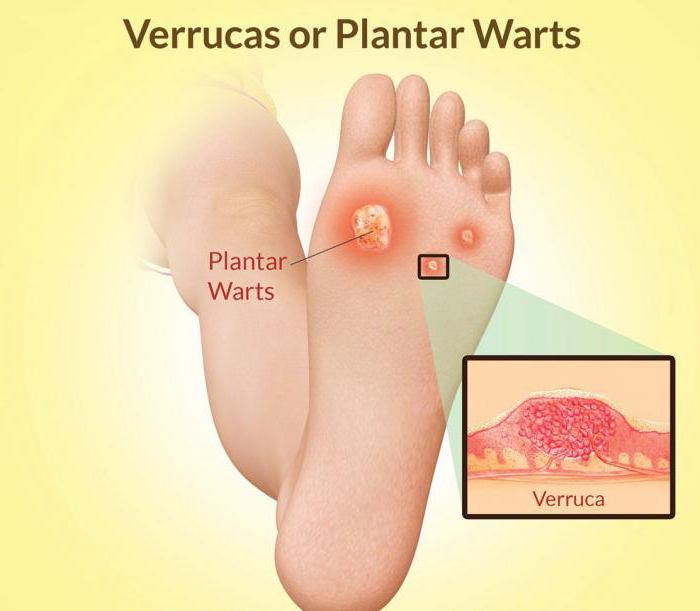
You can suspect that a person has a plantar wart by the absence of a skin pattern on its surface. Also a characteristic feature of these formations are points from thrombosed capillaries. If they are present, then the doctor can distinguish plantar warts even without PCR diagnostics. Laser removal is best done after an ultrasound. With the help of this study, it is possible to determine to what depth the root of the neoplasm has grown.
People with plantar warts often complain of discomfort and pain when walking.
Why do black dots appear in warts?
Safe warts and papillomas have a uniform pink or brown tint, smooth edges, and do not rise much above the main skin. If you notice that black spots have appeared, consult your doctor immediately; the cause of the changes may be hidden in:
- the immune system is activated and begins to attack cells infected with the virus, as a result of which they die and change color;
- an infection penetrated into the formation and, upon contact with HPV, changed the pathogenic cells to a different color;
- black dots on a wart are caused by medications for external use.
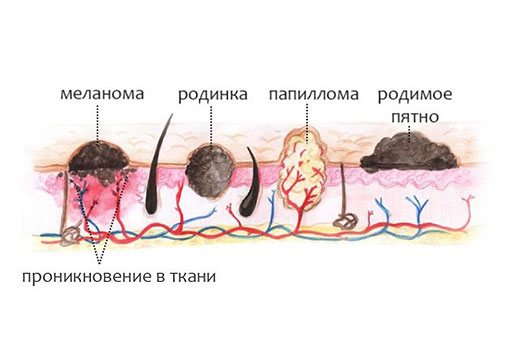
Is this dangerous and what does it indicate?
A wart with a black dot inside is not dangerous, but indicates changes that are not typical for the papilloma virus. When the heel or foot rubs, the functioning of the capillaries is disrupted. Droplets of blood remain inside the growth in the form of red rods or dark red dots. This is not life threatening, but serves as a warning. It is necessary to protect education from unnecessary contact with shoes, clothing and mechanical friction.
A black spot on a mole and wart may be ordinary dirt that has penetrated into the upper layers of the skin on the growth. To get rid of a mole, apply hydrogen peroxide or treat with an antiseptic.
The interaction of pathogenic skin cells infected with the papilloma virus with some medicinal plants gives a symptom in the form of dark spots. Celandine destroys the formation at the cellular level and over time a crust forms on it. Some people perceive the initial stages of crust formation as dark spots and rush to look for the “root of trouble” in oncology. You should not panic prematurely; only a doctor can make an accurate diagnosis based on test results and instrumental diagnostics.
Danger awaits a person if:
- the black spot on the wart begins to itch;
- provokes swelling of nearby areas;
- hurts;
- bleeding;
- grows;
- emits a clear liquid.
Sometimes the wart becomes covered with dots of a different color after using liquid nitrogen or radio wave surgery. The growth is removed in a hospital setting, but the root is left, and it is this that causes the problem. If, after removing the formation that rises above the general cover, leaving the root (manifested externally in the form of a point), the treatment does not give results, papillomas will appear in the same place. You should not pull the root yourself - it can cause bleeding.
In old age, papillomas with a black dot may indicate vascular disease, and are not associated with papillomavirus. When natural aging of the body occurs, the skin recovers more slowly, often incorrectly. From an ordinary cut, growths can form, and clogged vessels trapped inside the formation take on the appearance of black dots.
Localization Features
Formations with black specks inside are formed in places of increased exposure to sunlight, cauterization with medications, and increased contact with a mechanical surface. According to statistics, this type of formation is formed on the feet, where the skin is more dense and is constantly exposed to shoes and friction when walking. Such warts are called plantar warts.
The type of formations with blackheads rarely forms in young people. The virus affects middle-aged people. In older people, growths with black dots are considered normal; they can appear on the feet and other parts of the body. Senile warts do not cause discomfort or pain; they are a cosmetic defect and a sign of aging.
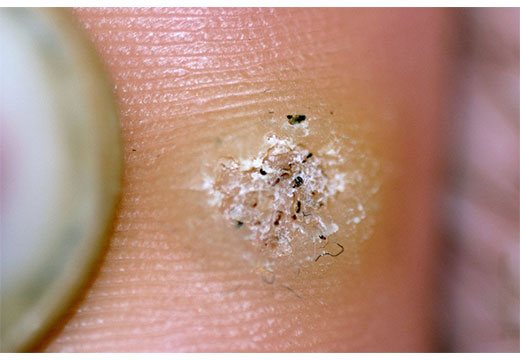
Methods for removing warts with blackheads
You can get rid of blackhead warts with medications or surgical removal techniques. Everyone must choose their own treatment method, but only after consulting a doctor. For conservative therapy use:
- Viferon;
- Fresol;
- Isoprinosine;
- Panavir;
- Castor oil;
- Collomak;
- Cryopharma.
If medications do not work, the skin defect can be removed surgically. Removing small growths is not painful; the doctor uses anesthesia; only a scar on the skin will remind you of the operation. Among modern technologies for removing warts and moles, laser therapy and cryodestruction can be noted. In the first case, the formation is exposed to a laser beam, which dries the cells of the growth, and it disappears. During cryodestruction, liquid nitrogen is used, which destroys the growth cells by freezing. Both methods of removal are painless and give 100% results; there is no recovery period. The patient goes home after the procedure.
Treatment of warts with celandine
The removal of warts with celandine shows excellent results. Every person at least once in his life has encountered skin formations such as warts.
The nature of warts
They can be found on your own skin or seen on other people. But the main thing is that the occurrence of warts has nothing to do with gender and age; they can develop on the body of any person.
Warts are not dangerous to human health. The feeling of discomfort from their presence makes people think about the need to remove them. Dermatology has several very effective methods in its arsenal.
Useful properties of celandine
Celandine is one of many herbaceous plants. It has a root system, a branching stem with large pinnately divided leaves of different colors (green at the top and blue at the bottom). It blooms in early summer and ripens in early autumn.
It is quite poisonous; when cutting and breaking the stem, you can observe the release of yellow juice with an orange tint.
It is advisable to adhere to the basic rules of protection when using the plant (wear gloves to avoid the risk of burns and glasses to avoid getting the plant juice into your eyes).
To enhance the medical effect on warts, celandine must be collected at the time of its flowering. It is advisable to choose celandine with a bright green base without visible damage to the stem and leaves.
Common names for celandine
Celandine has many different names. In ancient times it was called "swallow grass" because its flowering begins and ends with the coming and going of swallows.
In Russia, the plant got its name because of its cleansing properties; it can remove age spots, pimples, and growths. Burning out warts is especially popular; celandine really quickly removes them.
- Today, celandine is used in both traditional and modern medicine for therapy in the fight against tumors on the surface of the skin.
- When developing new medicines, ointments and other medicines, an extract of this plant is used.
- The effectiveness of celandine is due to the presence of alkaloids in it, which exhibit a bactericidal effect.
- The roots and leaves of the plant are also used for medicinal purposes.
Treatment of growths using celandine
How to treat warts with celandine? Doctors recommend using juice, tinctures, oils and compresses to treat skin lesions with celandine.
The easiest way to use this plant is to wash away the wart with freshly squeezed juice of cut celandine.
It is important to follow certain rules when using the plant. First, the affected area must be thoroughly cleaned and steamed in hot water with salt.
The sap of the plant is quite poisonous in contact with normal skin and can cause burns.
The areas of skin in the area of the growth should be lubricated with any fatty cream.
- After this, the celandine juice is squeezed onto a cotton swab and applied to the affected area 2-3 times a day.
- To enhance the effect and speed up the healing process, the resulting crust (dead skin cells) is removed after the procedure.
- The plant must be used daily until the growth completely disappears.
The plant is very effective in treating warts using compresses.
- You need to take the leaves of the plant, trim them, rinse them with water, squeeze the valuable juice into a glass and mix it with 70% alcohol.
- The tincture must be sealed and placed in the pantry for several weeks.
- Then you need to prepare the infusion filter.
- It is recommended to lubricate it 2-4 times a day or put soaked gauze on it.
- It is advisable to apply it to the affected area for 20 minutes for one week.
If the wart begins to hurt after using celandine, you must immediately stop the procedure and consult a specialist.
Recipes with celandine
Celandine juice is very compatible with propolis (in a ratio of one to five).
- The mixture should be stored in a dark place for 2-3 days.
- The prepared solution is applied to skin formations as a compress 2 times a day.
- The treatment regimen lasts one to two weeks.
- It is recommended to hold the compress for no more than 20 minutes.
- The wart almost completely disappears after celandine.
Oil
Celandine is also added to oil for the treatment of skin tumors. Place washed and chopped celandine leaves into a half-liter jar, fill them with unrefined vegetable oil, close the jar, shake it and leave it in the sun for 14 days.
After this, the infusion is ready for use as a compress.
- It is necessary to moisten gauze in the solution and apply it to the area of the growth for approximately 12 hours.
- Experts recommend carrying out such therapy for skin lesions for one week.
It is possible to prepare a medicinal ointment from celandine; it is very useful during the treatment of warts on the feet. The plant juice is mixed with glycerin in a ratio of four to one and stored in a cool place.
Decoctions
You can drink a decoction of the plant (exclusively after consulting your doctor). For one liter of boiled water, take about 20 g of dry celandine leaves and leave for two hours. After this, drink 3 times a day before meals.
Buy at the pharmacy
Each pharmacy has a wide selection of various medicines with celandine in their composition (solutions, extracts, ointments). They are used quite effectively to remove any types of growths.
Possible complications and precautions
Sometimes it is not worth removing the formation. When exposed to the drug, pathological processes are triggered. Consult your doctor; the growth may not be something to worry about.
It is easier to prevent the development of formations than to deal with the consequences and eliminate the growth. Prevention of the appearance of warts with a blackhead consists of following the rules of personal hygiene, especially for the legs and feet, where they are most often localized. Excessive sweating of feet in shoes provokes the spread of the virus. Reduced immunity contributes to the activation of the virus. Try to eat more vitamin-containing foods and avoid contact with people with HPV.
The papilloma virus is difficult to cure. By seeking help in a timely manner, you will prevent the virus from going into remission. Old warts can be removed without consequences, and new ones will not appear. The skin will be clean again without unpleasant growths.


